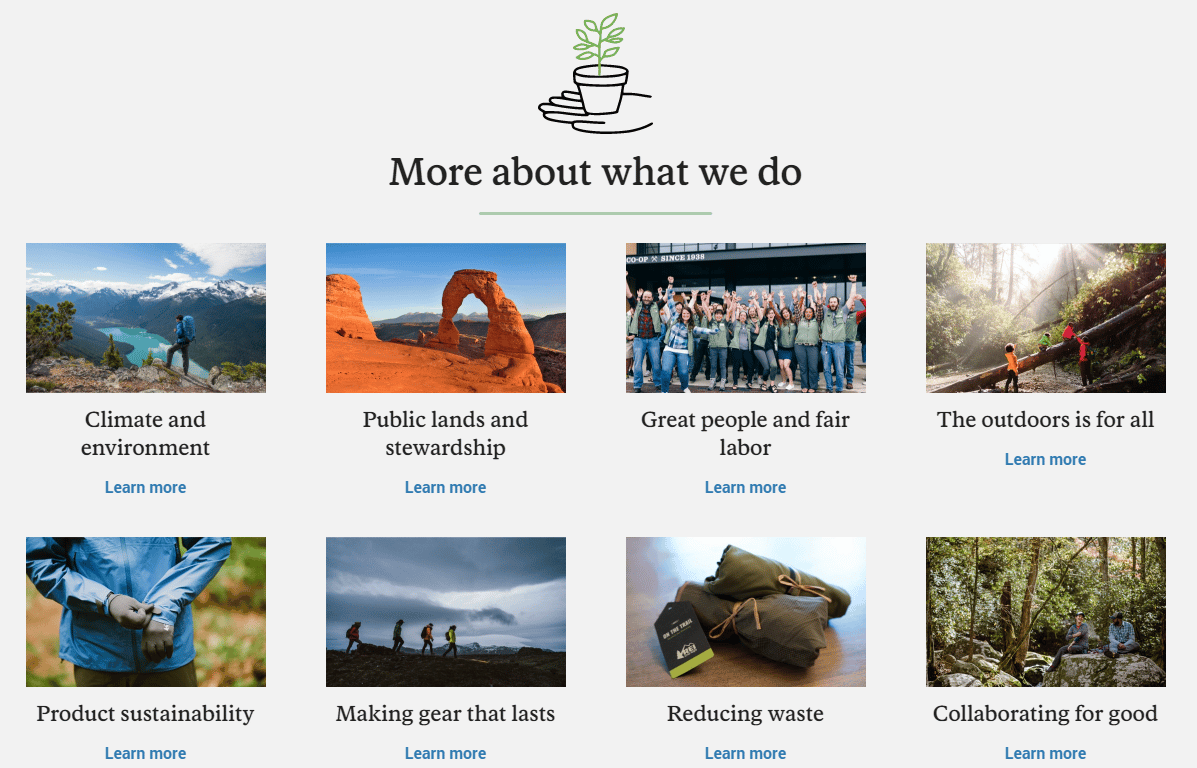
Building a Purpose-Driven Brand: The Why and How
Does your purpose currently impact your marketing, revenue growth, and profit? If not, it should.
Here’s why:
According to research, curated by Mack Fogelson, consider the following:
- 73% of people care about the company, not just the product when making a purchase. (BBMG)
- 50% of purchases are made because of word-of-mouth (Brains on Fire)
- 85% of purpose-led companies showed positive growth (Harvard Business Review/EY)
In sum, purpose matter because it impacts your growth, revenue, and profit.
Purpose-driven brands such as Google, 3M and Chobani are all in on a little marketing secret. The best way to make money is to not prioritize profits. This is because the only way to become successful – and to sustain that success – is to have something that is unaffected by external forces as the foundation of your business. You need a purpose.
Why the purpose-driven business model has worked so well for some of the world’s largest companies is because core values will still be there when the market shifts or customer preferences change. Brand purpose is the pillar that stands tall, unmovable, as the world turns. When you use this foundation as the unifying force of your marketing strategy, you are tapping into an infinite source of inspiration to energize your campaigns – instead of chasing the carrot, which is what happens when business decisions and bottom-line needs are what motivate your marketing decisions.
Feel like that frustrated horse, never quite getting a bite of that out-of-reach carrot? Take a lesson from the playbooks of these purpose-driven brands.
The Case for Purposeful Branding
An Accenture study found that 63% of global consumers prefer to purchase from purpose-driven brands. Most participants (74%) cited transparency and ethical business practices as key considerations.

CMOs can’t analyze their way to those qualities. “It’s about having a genuine and meaningful commitment to important principles that consumers care about — such as health and wellbeing, natural ingredients, environmental sustainability and family connections — which inform every business decision,” Bill Theofilou, Accenture Strategy’s senior managing director, explains.
When CMOs spend on tools in place of brand principles, share prices suffer. Forrester’s research showed that companies redirecting agency spend toward technology and paid media frequently had negative results. Many companies spend inordinate resources developing in-house data science teams when cheaper and faster third-party options could achieve comparable results. In turn, they don’t divert spend from creative efforts.
Although agencies aren’t telling companies to abandon martech altogether, they’re trying to pull back the curtain on its true costs. B2B strategy firm Renegade’s CMO survey found that while software and tools promise big returns, they also increase complexity. “Our study found that 90% of B2B marketers noted a massive increase in complexity caused by having more target audiences, more technology to integrate and more data to sift through,” explains Renegade CEO Drew Neisser. “Unfortunately, this increase in complexity has not resulted in improved marketing performance for many B2B CMOs.”
Tools like CRM systems play a vital part in customer connection, and marketing teams will never return to mail-only copywriting. But no amount of data analysis can replace building awareness and other activities that drive branding. CMOs must first appreciate and invest in building strong brands if they want to reap the value of marketing tools.
Understanding Your Brand Purpose
Company leaders can’t fake a purpose. Customers quickly call foul when a company holds a social position it doesn’t back up with action. To build a brand that stands up to scrutiny, the leaders of your company must agree on and work toward a shared purpose.
That purpose doesn’t need to be purely philanthropic to appeal to audiences. REI, for example, incorporates conservationism into its core business processes.

Choose a cause that makes sense for your company’s market and resonates with your leadership team. Lean into that purpose to refine your branding as you grow.
Your Brand Purpose Has to Make a Positive Difference
Not only are consumers starting to avoid brands that don’t align with their values, but there is an increasing expectation that businesses should be proactively making a positive impact. 88 percent of consumers want brands to make the world a better place.
One of the pillar companies that set the bar for ongoing social involvement is Starbucks. From striving towards 100 percent ethically sourced coffee and participating in community service, to launching a climate change strategy – way before other brands were moving in this direction – Starbucks has always had a reputation for pushing social and environmental issues.
Starbucks started out as one Seattle coffee shop in the Pike Place Market. From 1982 to 2015, the company opened more than 22.5K stores worldwide under the leadership of Howard Shultz. Shultz joined the company as the director of retail operations and marketing and stepped down from his role as CEO at the end of 2016.
Shultz was known for sparking the brand’s core visions and for keeping those flames alive for decades. “What is the role and responsibility of a public company … and how can we catalyze hope in a time when we need more optimism, compassion and leadership?” he questioned.
Answer this riddle for your brand and you have the eternal heart of your marketing strategy.
Starbucks hasn’t always pulled off purpose with flying colors, however, such as their epic #racetogether marketing failure. And here’s where you can learn the most essential advice from this purpose-driven brand – make sure your company’s organizational culture matches your brand’s messaging. Starbucks was criticized for launching a marketing campaign to promote race relations when their own leadership team could barely be considered as diverse.
Purpose Enables You to Connect Better with Customers
Most companies are pushing their product and their services rather than really leading from what their business is here to do and bridging that gap between the purpose of the company and the people that are in line with that. So, when the conversation is about the product, there isn’t much of a conversation to be had.
Let’s say we’re just talking about Dove. They sell soap. But ultimately their aim is to help women feel good about their bodies. So, it’s the intersection of those things (selling soap and helping women feel good about their bodies); the cultural relevancy of attacking an issue like women’s self-image and body image and wanting actually to help solve that problem in our world is what has given Dove such incredible growth in their organization.
When the conversation shifts from being about the product to being about purpose it becomes something else entirely that drives growth because it’s the word of mouth that companies are looking for. And that doesn’t come through talking about a product; it originates from the connection that they have with the shared values and wanting to do something bigger. Not to say that they don’t generate significant profits from this path; it’s just a different way to it.
At the same time, your customers should relate to the stated purpose.
Heineken’s Moderate Drinkers Wanted marketing campaign is helping to transform the way society views social drinking. The health effects of binge drinking, the dangers of driving under the influence and the destruction of alcohol addiction – society has some very real problems to tackle when it comes to alcohol consumption. Yep, you guessed it: we need a hero.
The beer maker has stepped up the pressure on consumers as well as the industry as a whole to promote responsible drinking through the success of their drinking in moderation marketing messaging.
Heineken, like other purpose-driven brands, has much more than a one-shot positive impact campaign. From the brand’s Supplier Code, which demands humane working conditions and environmentally responsible agriculture, to the sustainability initiatives to save water and boost efficiency, driving positive change is part of who the brand is.
Deconstruct the Customer Journey
So, now I’m getting specific to sales, marketing, customer experience and those teams in your organization and understanding how to do this by talking to your customers. Just as I mentioned earlier, you definitely want to be looking at the customer data that you can collect digitally. Understand the audience data, the demographic data, psychographic data that you get. But that is typically where companies stop.
They build these personas and then they don’t go any deeper into actually spending face time with the customer. And that’s where all the good stuff is. That’s where you’re going to find connections, and that’s where you’re going to understand what your customers are thinking and feeling at every stage in your funnel so that you can generate resources, content, experiences that help to remove those roadblocks. So, that’s the second part, deconstructing that customer journey so that you can make that bridge between your purpose and your people.
Technology Gets in the Way of Connections
Many people think that technology is a magic pill; they believe that there must be a tool or piece of technology or software that is going to help them build their customer base faster. The fact of the matter is that technology is part of the root of the problem in which companies need a purpose; they need empathy because they’re trying to solve these much deeper connection issues with their customers by using technology instead of speaking with their clients. Tools and technology can’t help you do that.
So, I think the companies that understand how to use technology wisely need to be able to use these tools at a certain level, even just to do a bunch of the heavy lifting and dirty work that we couldn’t take part in many years ago. But success is in taking that data and pairing it with the one-to-one participation in the flesh with these people to understand who they are, what they need really, and to help them get their roadblocks removed.
The very thing that’s supposed to help us (technology) connect with our customers more efficiently and effectively, is getting in the way of doing that. And so, to counteract that, or the counterpoint, is humanizing and putting more energy into that human connection so that when we do apply the technology, we’re using it well, and in a way that can help facilitate conversations and connections that we’ve already established.
Martech Doesn’t Negate Purpose
The optimal brand experience differs from company to company. That might sound obvious, but it evidently isn’t to some CMOs: By overly relying on martech, they’re creating an expensive — and unremarkable — brand experience.
According to research from Forrester, CMOs are spending more on tech than any other C-suite members. Through 2025, CMOs are projected to increase their spend on automation, data, and tools by up to 11%. Over that timeframe, they’re expected to boost their agency services spend by 2.4%. Under pressure to prove ROI at every turn, CMOs are sacrificing creativity for a more trackable but potentially less effective strategy.
Nobody can blame CMOs for wanting better tools and tracking. They can’t, however, forget the branding investments that helped them grow to what they are today. Customers have more choices than ever — they aren’t going to waste time on brands that look and act like all the rest.
Martech without branding leads to an undifferentiated, bland experience; branding without the right tools limits the company’s ability to reach new audiences and earn more business. It goes both ways.
Empathy Is Key to Communicating Your Purpose
One of the biggest things that we see is that companies lack the customer connection and, apparently, the connection to their purpose and any type of authentic or personal or empathetic connection to their customer. Because they’re using data to make decisions (which they have a copious amount of) some companies just don’t know what to do with it anymore. Success is not in just analyzing your customer data or your audience data or the psychographic data that you get
Success is not in just analyzing your customer data or your audience data or the psychographic data that you get on your customers. It’s participating in one-to-one interviews with them to understand their behavior truly and, more accurately; knowing what they’re thinking and feeling. Because when you just get that digital data about your customer, it gives you some very quantitative benchmarks about the profile of these people, but it doesn’t tell you what they’re afraid of; it doesn’t say what they’re struggling with right now at this point in their lives.
Connecting with your customers on that one-to-one basis obviously opens up a huge conversation for understanding and empathizing with where they’re coming from. But then, by understanding that thinking and feeling, you can then shape your entire content strategy based on removing those roadblocks. And that is something I think ties into many things, in addition to purpose and empathy.
I often talk to marketers who really don’t get to spend face time with the customers they’re looking to influence or reach outside their companies. I think the takeaway here is that marketers need to spend more time connecting with clients, not just through their channel of their sales team, but actually having these conversations and spending time practicing and using their empathy to do just that.
Clarify Your Organizational or Brand Purpose
We talked a little bit about Dove. Their purpose is not to sell soap: their purpose is to help women feel better about their bodies. So that’s a big difference there.
Same with Chipotle. Their purpose is not to sell burritos: their purpose is to make food with integrity, and ultimately to pioneer food safety systems and help other fast food organizations to know that they can make great food and still make it healthy and good for our earth.
It’s kind of like understanding the difference between just a mission and the product that you’re selling and actually making the conversation about purpose. So, start there. If you’re at a loss as to how to do that, there are lots of resources online. And that is how you find your purpose. It’s not easy to do, but it’s certainly a place that will make you extremely relevant in your customer’s lives.
Keep Your Brand Story Consistent
Great brands adhere strictly to their style guides for written, audio, and visual content. Your style guide should not only cover details such as colors and grammar (e.g., Chicago versus AP style), but it should also clarify company stances on things like tone and important social issues. Treat style and branding guides as living documents that require regular updates to remain relevant.
Begin your style guide with your company’s purpose and core values, and look back to those values as you encounter potential conflicts. REI would lose customers in droves if it partnered with an oil drilling firm or a logging company in the Amazon, for example. No short-term profits can make up for a betrayal of your brand.
Purpose Inspires Sales – If You’re an Honest Brand
Is there anything that screams purpose over profit like Patagonia’s anti-growth strategy? Patagonia has been a strong-willed socially responsible brand since the beginning. When the business opened its first store in 1988 and learned that formaldehyde from their cotton clothing stored in the basement was giving their employees headaches, they commissioned their own study on conventional cotton. After what they learned from their research, they went completely organic.
Once they started paying attention, they never stopped. “Living the examined life,” noted founder Yvon Chouinard, “is a pain in the …” They’ve been measuring their environmental impact for years. They offer more employee benefits than Santa Claus. That 1 percent across the board sales donation isn’t viewed as philanthropy, not by this brand. It’s seen as a meager attempt to balance out their own negative environmental impact.
By 2011, the brand’s existential crisis reached a new level. Patagonia started advertising to motivate people to not buy their products, pointing out the environmental impact of each product’s lifecycle.

They launched their infamous Black Friday ad “Don’t Buy This Jacket.” Over the next couple years, they continued this negative consumption cycle messaging in their email marketing, social media channels and their website. Sales jumped by 27 percent. The Black Friday anti-buy add alone led to a 30 percent spike in sales.
Patagonia’s marketing doesn’t just push for transparency. This is brutal honesty. Not something you see every day, which is why it grabbed so much attention.
The reason a bold marketing initiative like this worked at all is because Patagonia had the substance to back it up. Imagine if one of the many clothing retailers who have been accused of worker abuse in their overseas textile factories tried something similar – honest marketing only works if your core values are lived and breathed.
Why Should B2B Marketers Care About Purpose?
Purpose is becoming more of a trendy topic; you see it everywhere and I think that’s the biggest disconnect. Companies think that, on the outside, if they market with purpose, they’re good; they’re safe. And maybe many companies are doing that. But if then the experience with your business is not real all the way to the core, then that’s where you’re going to have significant problems (think about recent events with companies like Uber, United, and Pepsi’s commercial fail).
Ultimately, in the day-to-day, companies want to know how do we achieve growth and how do we continue to acquire customers? How do we keep our customers? When your business is not looking at how to build a deeper connection with that customer (which comes from purpose and empathy as we’ve talked about) there is no connection. When you have no connection, you have no customers.
It’s really in applying the purpose to the day-to-day of the organization and understanding that it’s not just some visionary thing, but it’s about identifying your purpose and then making it relevant to your customers. It’s helping your teams understand what purpose is or isn’t. Many companies think it’s a PR approach or it’s a tag line, or it’s a mission or value statement. And that’s all great, but when it comes down to it, the purpose is really what does that mean to your customer who needs your product and wants to connect more deeply with your company?
Think about Patagonia: they’re selling a stellar product, but they’re also going deeper to say, “We are going to pioneer technology to make better clothing. And we’re going to reduce the impact of that on the environment. Then we’re going to give this technology to our competitors because if they have it, then we’re making a larger impact altogether.”
Companies need a purpose. Because they need to keep their employees; they need purpose to keep their customers, and ultimately there’s something bigger that their businesses are here to do, and it’s not an altruistic path. It’s a road to profit, it’s just, again, a different way of getting there.
Leading the Way – Bringing Purpose to Your Company
How can leaders get the conversation about brand purpose started inside their company?
Purpose as a concept seems very intimidating, especially to leaders, because they feel like “Oh my gosh, you’re talking about an entire organization overhaul, and we can’t even keep up with what we’re doing every day.”
It’s not really starting over, it’s just optimizing what you have, and better connecting it and communicating it so that your employees and your customers can understand it. So, I think it’s just starting small.
You can typically start with a small purpose workshop. We’re talking maybe 45-60 minutes of helping companies understand what purpose is and what purpose isn’t. Sometimes, “purpose” seems kind of fluffy, maybe, when you’re trying to hit your ROI and your metrics and the goals that you have financially for your team and for the organization. But leaders need to convey to the whole team that purpose is not something fluffy or intangible. This is about real growth. And in this day and age, this is the approach to growth.
But when you’re selling it to your leadership, the pitch is, “We’re going to teach our sales, marketing, and customer experience teams how to remove roadblocks for our customers by connecting that purpose. And that, ultimately, is going to drive connections, retention, and sales.”
Connect Your Organizational Purpose to Each Team’s Purpose
A critical step in getting purpose really well integrated into your organization is connecting your team’s purpose to your organization’s purpose. Ultimately, you have to know the purpose of your organization in its entirety to really understand why your organization, as a whole, exists beyond making money?
With your team: understand what role they play in achieving that purpose so that they can apply that more specifically to their day-to-day. That can go a really long way toward efficiency, output and morale, especially when your team is pushing hard and days are getting long. The meaning side of that really matters to them.
Communicate Your Purpose to the World
This very much directly applies to your sales and marketing and customer experiences team. They’re the most outwardly-facing, and they have the biggest responsibility in making sure that what is happening inside of your organization is also being effectively communicated outside, so customers know you’re not a façade; that purpose is not a veneer and that it’s truly how you operate inside and out.
You want to teach your sales and marketing team to understand the difference between having a product conversation and having a purpose discussion. When you make that shift to not just pushing your product, but to helping those teams understand the bigger purpose of your organization and how that connects to your customers, you’re opening an opportunity to connect with exponentially more people, more organizations, more influencers, more people in the media, more communities, who are either already your ideal customers, or they know somebody who could be.
Get Fans Involved
Use your marketing communication tools to empower your fans to spread the word about your brand. Incentivize word-of-mouth marketing by using a loyalty program and frequent outreach to create a sense of community. Your best customers engage with your brand as if it were an extension of their own personalities, so treat them as part of your brand family to foster inclusivity.
Martech can help you identify which customers would make great ambassadors. Who consumes your content and shares it on social media? Who spends the most time on your website and clicks through most of your emails? By targeting those fans with special messaging and promotions, you can bring your brand story to new audiences.
CMOs can’t afford to ignore technology, but they can’t be blind to its shortcomings, either. Martech multiplies your resources if — and only if — you don’t jettison best practices in the process. Before you cut your creative spending and put everything into analytics, realize that optimization is meaningless without a strong brand to stand on.
Being It to Believe It
These purpose-driven brands each have their own causes to champion and progressive struggles to overcome. But, there is one essential takeaway they all offer. If you want to convince consumers that there is meaning behind your brand, purpose has to extend far beyond the marketing team. It has to permeate the entire organizational culture. This isn’t about listing well-intentioned brand values or sponsoring a local little league team. This is about continually searching for ways that your brand can enact positive change.
And, it’s about engaging your customers. Because, if your purpose really matters, you’ll need their help to make a difference.






